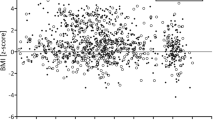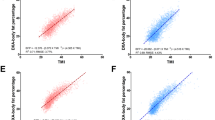Abstract
Objective: To investigate the relationship between food energy and macronutrient intake and body fatness assessed up to seven times between 2 and 15 y of age.
Design: Prospective, observational study. Generalised linear estimating equations were used to evaluate the longitudinal relationship between body fatness and macronutrient intake. Regression analysis was used to assess whether body fatness at a particular age was predicted by intake at any of the previous ages.
Setting: Community-based project in Adelaide, South Australia.
Subjects: In all 143–243 subjects from a representative birth cohort of healthy children recruited in 1975 and followed over 15 y.
Main outcome measures: The dependent variables were body mass index (BMI), triceps (TC) and subscapular (SS) skinfolds, expressed as standard deviation (s.d.) scores at each age. The predictor variables were energy-adjusted macronutrient intake and total energy intake, estimated from a 3–4 day diet diary, the previous corresponding measure of body fatness, sex and parental BMI, TC or SS.
Results: Across 2–15 y energy-adjusted fat and carbohydrate intakes were respectively directly and inversely related to SS skinfold measures but not to either BMI or TC skinfold. The best predictor of fatness was previous adiposity, with the effect strengthening as the age interval shortened. Parental BMI, maternal SS and paternal TC contributed to the variance of the corresponding measure in children at some but not all ages.
Conclusions: The current level of body fatness of the child and parental adiposity are more important predictors than dietary intake variables of risk of children becoming or remaining overweight as they grow.
European Journal of Clinical Nutrition (2001) 55, 471–481
This is a preview of subscription content, access via your institution
Access options
Subscribe to this journal
Receive 12 print issues and online access
$259.00 per year
only $21.58 per issue
Buy this article
- Purchase on Springer Link
- Instant access to full article PDF
Prices may be subject to local taxes which are calculated during checkout
Similar content being viewed by others
References
Bandini LG, Schoeller DA, Cyr HN & Dietz WH (1990) Validity of reported energy intake in obese and nonobese adolescents Am. J. Clin. Nutr. 52 421–425
Bell EA, Castellanos VH, Horwat ML & Olls BJ (1998) Energy density of foods affects energy intake in normal-weight women Am. J. Clin. Nutr. 67 412–420
Boulton TJC (1981) Nutrition in childhood and its relationship to early somatic growth, body fat, blood pressure and physical fitness Acta Paediatr. 284 (Suppl), 1–85
Boulton TJC, Cockington RA, Hamilton-Craig I, Magarey AM & Mazumdar J (1995) A profile of heart disease risk factors and their relation to parents' education, fathers' occupation and family history of heart disease in 843 South Australian families: the Adelaide Children's WHO Collaborative Study J. Paediatr. Child Health 31 200–206
Brook CGD (1971) Determination of body composition of children from skinfold measurements Arch. Dis. Child. 46 182–184
Cole TJ, Freeman JV & Preece MA (1995) Body mass index reference curves for the UK, 1990 Arch. Dis. Child. 73 25–29
Cole TJ, Bellizzi MC, Flegal KM & Dietz WH (2000) Establishing a standard definition for child overweight and obesity worldwide: international survey Br. Med. J. 320 1240–1243
CSIRO Division of Human Nutrition (1980) CSIRONET Diaryan Program Adelaide: CSIRO Division of Human Nutrition
Davies PSW (1997) Diet composition and body mass index in pre-school children Eur. J. Clin. Nutr. 51 443–448
Davies PSW, Day JME & Cole TJ (1993) Converting Tanner–Whitehouse reference tricep and subscapular skinfold measurements to standard deviation scores Eur. J. Clin. Nutr. 47 559–566
Deurenberg P, Pieters JL & Hautvast JGAJ (1990) The assessment of the body fat percentage by skinfold thickness measurements in childhood and young adolescence Br. J. Nutr. 63 293–303
Fox K, Peters D, Armstrong N, Sharpe P & Bell M (1993) Abdominal fat deposition in children Int. J. Obes. Relat. Metab. Disord. 17 11–16
Gazzaniga JM & Burns TL (1993) Relationship between diet composition and body fatness, with adjustment for resting energy expenditure and physical activity, in preadolescent children Am. J. Clin. Nutr. 58 21–28
Goldberg GR, Black AE, Jebb SA, Cole TJ, Murgatroyd PR & Coward WA et al. (1991) Critical evaluation of energy intake data using fundamental principles of energy physiology. 1. Derivation of cut-off limits to identify under-recording Eur. J. Clin. Nutr. 45 569–581
Grundy SM (1998) Second international conference on fats and oil consumption in health and disease: overview Am. J. Clin. Nutr. 67 (Suppl 3), 497S–499S
Guillaume M, Lapidus L & Lambert A (1998) Obesity and nutrition in children. The Belgian Luxembourg Child Study IV Eur. J. Clin. Nutr. 52 323–328
Horton TJ, Drougas H, Brachey A, Reed GW, Peters JC & Hill JO (1995) Fat and carbohydrate overfeeding in humans: different effects on energy storage Am. J. Clin. Nutr. 62 19–29
Liang KY & Zeger SL (1986) Longitudinal analysis using generalised linear models Biometrika 73 13–22
Lissner L & Heitmann BL (1995) Dietary fat and obesity: evidence from epidemiology Eur. J. Clin. Nutr. 49 79–90
Maffeis C, Pinelli L & Schutz Y (1996) Fat intake and adiposity in 8 to 11-year-old obese children Int. J. Obes. Relat. Metab. Disord. 20 170–174
Maffeis C, Talamini G & Tato L (1998) Influence of diet, physical activity and parent's obesity on children's adiposity: a four-year longitudinal study Int. J. Obes. Relat. Metab. Disord. 22 758–764
Magarey AM & Boulton TJC (1987) Food intake during childhood: percentiles of food energy, macronutrient and selected micronutrients from infancy to eight years of age Med. J. Aust. 147 124–127
Magarey AM & Boulton TJC (1994) The Adelaide Nutrition Study. 1. Food energy intake through adolescence: including an evaluation of under-recording, age and sex differences. Aust. J. Nutr. Diet. 51 104–110
Magarey AM, Daniels LA & Boulton TJC (2001) Prevalence of overweight and obesity in Australian children and adolescents. Assessment of 1985 and 1995 data against new standard worldwide definitions Med. J. Aust. (in press).
McLennan W & Podger A (1998) National Nutrition Survey Nutrient Intakes and Physical Measurements Canberra: Australian Government Publishing Service
Nelson M & Bingham SA (1997) Assessment of food consumption and nutrient intake In Design Concepts in Nutritional Epidemiology, 2nd edn, ed 3. BM Margetts & M Nelson 149–150 Oxford: Oxford University Press
Nguyen VT, Larson DE, Johnson RK & Goran ML (1996) Fat intake and adiposity in children of lean and obese parents Am. J. Clin. Nutr. 63 507–513
NHMRC (1997) Acting on Australia's weight: a strategy for the prevention of overweight and obesity Canberra: Commonwealth Department of Health and Family Services
Obarzanek E, Schreiber GB, Crawford PB, Goldman SR, Barrier PM, Frederick MM & Lakatos E (1994) Energy intake and physical activity in relation to indexes of body fat: the National Heart Lung and Blood Institute Growth and Health Study Am. J. Clin. Nutr. 60 15–22
Ortega RM, Requejo AM, Andres P, Lopez-Sobaler AM, Redondon R & Gonzalez-Fernandez M (1995) Relationship between diet composition and body mass index in a group of Spanish adolescents Br. J. Nutr. 74 765–773
Paul AA & Southgate DAT (1978) McCance and Widdowson's the Composition of Foods, 4th edn. London: HMSO
Prentice AM (1998) Manipulation of dietary fat and energy density and subsequent effects on substrate flux and food intake Am. J. Clin. Nutr. 67 (Suppl 3), 535S–541S
Robertson SM, Cullen KW, Baranowski J, Baranowski T, Shaouhua H & de Moor C (1999) Factors related to adiposity among children aged 3 to 7 y J. Am. Diet. Assoc. 99 939–943
Roche AF, Siervogel RM, Chumlea WC & Webb P (1981) Grading body fatness from limited anthropometric data Am. J. Clin. Nutr. 34 2831–2838
Rolland-Cachera MF, Deheeger M, Akrout M & Bellisle F (1995) Influence of macronutrients on adiposity development: a follow up study of nutrition and growth from 10 months to 8 y of age Int. J. Obes. Relat. Metab. Disord. 19 573–578
Shultz Y, Flatt JP & Jequier E (1989) Failure of dietary fat to promote fat oxidation: a factor favouring the development of obesity Am. J. Clin. Nutr. 50 307–314
Slaughter MH, Lohman TG, Boileau CA, Horswill RJ, Stillman MD, Van Loan MD & Bemben DA (1988) Skinfold equations for estimation of body fatness in children and youth Hum. Biol. 60 709–723
Torun B, Davies PSW, Livingstone MBE, Paolisso M, Sackett R & Spurr GB (1996) Energy requirements and dietary energy recommendations for children and adolescents 1 to 18 y old Eur. J. Clin. Nutr. 50 (Suppl 1), S37–381
Tucker LA, Seljaas GT & Hager RL (1997) Body fat percentage of children varies according to their diet J. Am. Diet. Assoc. 97 981–986
WHO (1998) Obesity. Preventing and managing the global epidemic Report of a WHO consultation on obesity. Geneva: World Health Organisation
Willett WC (1998) Nutritional Epidemiology 289–291 New York: Oxford University Press
Acknowledgements
We thank the young people in the Adelaide Nutrition Study who have patiently and cheerfully recorded their food intake and allowed themselves to be measured over many years, and especially their parents. The work was originally funded by the National Heart Foundation of Australia, and subsequently by the Adelaide Children's Hospital Research Foundation and the National Health and Medical Research council of Australia.
Author information
Authors and Affiliations
Rights and permissions
About this article
Cite this article
Magarey, A., Daniels, L., Boulton, T. et al. Does fat intake predict adiposity in healthy children and adolescents aged 2–15 y? A longitudinal analysis. Eur J Clin Nutr 55, 471–481 (2001). https://doi.org/10.1038/sj.ejcn.1601207
Received:
Revised:
Accepted:
Published:
Issue Date:
DOI: https://doi.org/10.1038/sj.ejcn.1601207
Keywords
This article is cited by
-
Modifiable risk factors in relation to changes in BMI and fatness: what have we learned from prospective studies of school-aged children?
International Journal of Obesity (2009)
-
The increase of fatty acid-binding protein aP2 in overweight and obese children: interactions with dietary fat and impact on measures of subclinical inflammation
International Journal of Obesity (2008)
-
Modifiable Environmental and Behavioral Determinants of Overweight among Children and Adolescents: Report of a Workshop
Obesity (2006)
-
Early adiposity rebound: causes and consequences for obesity in children and adults
International Journal of Obesity (2006)
-
BMI from 3–6 y of age is predicted by TV viewing and physical activity, not diet
International Journal of Obesity (2005)



